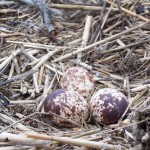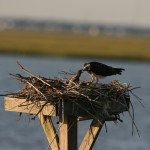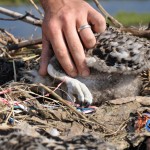Ospreys in New Jersey
Eggs will be hatching soon!
By Ben Wurst, Habitat Program Manager

Osprey pairs are very busy this month. Females are hunkered down in nests while incubating their eggs. They must keep their eggs at a temperature of around 99 degrees Fahrenheit. They must maintain this temperature for over 32 days and up to 43 days! Warm air temperature and normal precipitation are crucial during incubation. If there are periods of extended rain and cool temperatures, then the success rate at raising young decreases.
Eggs are incubated immediately after they are laid. This is referred to as asynchrony. This ensures that during times of low prey availability at least one nestling will survive to fledge or leave the nest. Disturbance is critical to incubating females now. If they must leave the nest, then the eggs are very vulnerable to the suns radiation, cool air temperatures, and predators. Females do 70% of the incubation duties.
While females are sitting there, incubating those eggs, males are mostly on the wing or perched near the nest. They provide almost all of the food to the female. They can fly a few miles from the nest, or only a few hundred feet to find prey (live fish). This is why ospreys nest near water, their source of food. The males ability to provide food to the female is also crucial to the success of the pair at raising young.

The young hatch (in the order that they were laid) and are born semi-altricial, or blind, feathered, and completely helpless. They are totally dependent on their parents to keep them warm and to provide them with food. They need very close parental care during the first week of life. After the first week the nestlings begin to more around more and begin exploring the surroundings in their nest. At three weeks of age (pictured at right) the nestlings can easily walk around the nest and often raise their heads to look around. Their contour (body) feathers and flight feathers begin to emerge from their protective sheaths during this time. The coloration of their feathers (dark brown with a buff feather tip) give them remarkable camouflage in the nest. Their coloration is very close to the nesting material ospreys use which consists of sticks, seaweed, marsh grasses, and human garbage like plastic bags, fishing line, and other trash.

I find a lot of ribbon from Mylar balloons every year. Some nestlings become entangled in the ribbon. If I do not get to the nest in time and remove the ribbon, then some may lose a limb or even die. It is not clear why adult ospreys choose to use fishing line and ribbon as nesting material. It may be because it is fairly common (unfortunately) in marine and estuarine ecosystems.
Keep an eye for hatching to begin two weeks from now. Females will not be sitting as much and they will be more aware of those eggs that are hatching beneath them. In late June and early July, volunteers throughout coastal areas will perform surveys by boat to determine the health of the population. I’ll post more updates soon on this in the coming weeks.
In the meantime, if you’d like to help, participate in coastal clean-ups or if you’re out for a walk or hike, bring a small trash bag and pick up some trash!